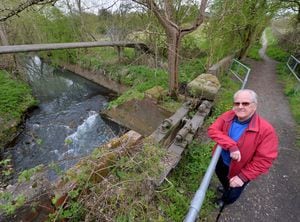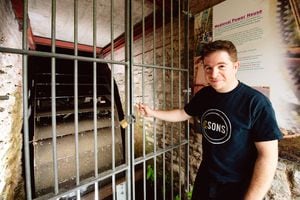Where there's a wheel, there's a way to power
On the one side of the road is an industrial estate, on the other a wedge of woodland between two housing estates.

A small river, really more akin to a stream winds its way through the greenery, before running beneath the road, where it passes the factory units, towards a nearby sewage plant. Richard Brooks reckons this could be a good site for a power station.
This week the Prime Minister is expected to commit to a 78 per cent reduction in carbon emissions over the next 14 years, leaving many wondering how we will manage to keep the lights on, let alone power millions of new electric cars.
But Mr Brooks, a trained civil engineer, reckons the use of water-driven turbines at sites such as the one at Stambermill, near Stourbridge, could play an important part in meeting that need.
“I would have thought you could build a weir here, that would produce electricity,” he says.
Mr Brooks has identified 32 former watermills along a short stretch of the Stour and its tributaries.
“The Stour is not a big river, you can often cross it without noticing, but it must have had enough power to drive these mills,” he says.
“I have often thought that, although many of the millpool sites have been built over, there are some sites that could be resurrected for power generation.”
Schemes
He is not the only person to have seen the potential of using historic watermills for power generation, although so far such schemes have been very much small scale.
Two such schemes have been running for some years in Ludlow.
There has been a waterwheel at Dinham Mill since the 14th century, when it was originally used grind wheat. Some 500 years later it was used to power the Chaplin Hodges brass foundry which opened in 1827. The arrival of coal, and later gas-fuelled, power stations rendered the watermill redundant, and during the second half of the 20th century, the building fell into a state of decline.
But now Dinham Mill has, like its large waterwheel, come full circle, and is once more being used to provide electricity for a cafe which operates from the building, as well as an office above.

Any excess power is sold to the national grid.
While the technology looks fairly simple, there is more to it than meets the eye. Keith Thomsen, a volunteer at Dinham, says it is crucial that the waterwheel rotates at a precise speed of seven turns a minute.
“There’s a gearbox inside, so that if the wheel spins at 11rpm, the generator turns at 1,500 to 1,600rpm. If it went faster than that, it would burn out the generator, so there is a failsafe device that shuts it down when that happens.”
To get the wheel turning at the correct speed, a set of impressive-looking iron sluice gates act as a dam to create the required water pressure.
“You need to have a drop of 90cm to get the water coming through at 500 litres per second,” says Mr Thomsen.
Half a mile along the River Teme is Ludford Mill, the site of a small hydroelectric power plant run by a co-operative for the past six years.
The turbine, known as an ‘Archimedes screw’ because the water drives an 8ft corkscrew-shaped device, rather than turning a traditional waterwheel, can produce more than 170,000 kWh a year – enough to power 45 homes.
Floods
However, last year’s floods also demonstrated the vulnerability of relying on energy supplies which are so dependent on the predictably unpredictable British weather.
Damaged caused by the February flooding left the mill out of action for three months, while repairs were carried out.
Mr Thomsen says that the topography of England in particular will probably mean that hydroelectric power will never play the central role in electricity production that it does in the UK.
“It might work in the mountains of Scotland or North Wales, but in England it is probably too flat, although if you have lots of little schemes, that all adds up to quite a bit.”
And it appears that local government is also realising the potential of using old-fashioned sources to meet the energy needs of the future.
Over the border in Llangollen, a popular spot with daytrippers from the West Midlands, town councillor Stuart Davies has suggested the current of the River Dee could be used to generate electricity.
“Given that Llangollen has a history as a mill town going back to the 13th century, it would be very exciting if the town council and national politicians could work together to bring some ‘Green Dee Power’ back to Llangollen,” he says.
In February this year, Shrewsbury Town Council revived plans to build a new weir on the Severn, which could potentially provide enough power for 400 houses.
Council leader Alan Mosley says: “The climate emergency makes it vital that we move to much more green energy and the hydro scheme at the weir will make a good local contribution to our objectives.
“There is significant community interest and support so that we very much hope that the feasibility study results in a positive outcome and that an exciting scheme can proceed.”





